
Desert Vibes: Creating a Desert Wonderland with Yucca Plants!
Published: 08/08/2024 | Updated: 08/08/2024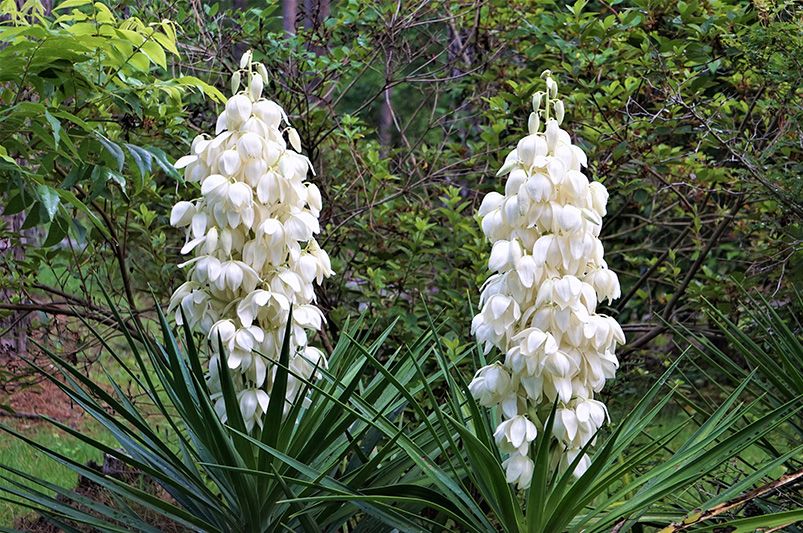
Like the red yucca and Adam’s needle, Yuccas come in various sub-types. Certain plants grow up to two feet a year, while others grow more slowly, about five inches. They are all quite resistant to drought. Most yucca species grow into monsters that take up a lot of room, but because they take so long to mature, you can use them as houseplants for many years before they take over your space. Most can be grown outside, even in temperatures as low as 10 degrees Fahrenheit. Certain types can even withstand temperatures below freezing.


Where To Plant Yuccas
Plant them in the early spring outdoors. Planting them too close to the house is not advised, though, as their invasive root systems can harm subterranean pipelines, sidewalks, and home foundations, even though they are not invasive species. The tall, spiky leaves of yucca plants have sharp ends that can cut you, so be careful when handling them. Pet owners should exercise caution when introducing yucca plants, as all of the plant's parts are poisonous to dogs, cats, and horses.
Growing Yucca Plants Outside
Most yuccas favor arid, sandy areas such as the Great Plains and the desert. They are naturally adapted to low-quality, sandy, well-drained soils in full sun and can withstand heat, drought, and salt spray. They have spread from Florida to New England and the Mississippi River. Placed in the right environment, outdoor yuccas are much more likely to bloom than their indoor counterparts.
Yucca plants should be planted outside, away from walkways and paths, since their sharp leaf tips can cut through clothing and hurt onlookers. As we mentioned earlier, their roots may also cause pavement disruptions. This plant does best in direct sunlight, but for best results, make sure it receives some afternoon shade as well.
If you cultivate your yucca plants indoors and want to bring them outside in the summer, harden them off for a few hours each day to acclimate them to life outside gradually. Plants can be gradually brought outside to lessen the risk of leaf burn or systemic shock. When the weather becomes colder, yucca species that aren't as hardy should be brought inside. Once more, gradually harden off the plants to help them acclimate to living indoors.
Indoor Maintenance of Yucca Plants
Yucca is not a demanding species and is great for beginner gardeners. Given the right conditions, they practically take care of themselves. Rather than receiving too much attention, they usually thrive on a little neglect. If planted outdoors, they can survive up to 20 to 50 years, and as houseplants, they can live for around five years. The one thing we advise against is the temptation to overwater them. Check their stems every now and again to gauge their thirst. Wet stems indicate an excess of water.
A well-lit, slightly dry area is the ideal indoor environment for yucca plants. Furthermore, few pests bother yucca plants. However, scale insects might occasionally cause problems. Yucca plants usually lose their lower leaves over time (they naturally droop and create a skirt around the trunk), which gives the plant a nice "tree-like" appearance.
- Light Needs: Bright, indirect light is ideal for indoor yucca plants. Intense, direct sunlight can generate white patches on leaves or crispy, brown tips, while too little light can lead yucca to grow thinner and slower.
- Soil Preferences: Naturally, yucca plants thrive in sandy environments. Plant your yucca inside in a loose potting mix that drains properly. Rich, fancy soil or specially designed soil is optional for low-maintenance yuccas. To encourage drainage, use a low-cost potting mix and add coarse sand and perlite for best results.
- Watering: During the spring and summer growing seasons, water your plant once a week, ensuring it has good drainage and dries out in between. As winter approaches, reduce the frequency of your watering to once every few weeks (or even fewer). Do not place your yucca plant in a tray filled with water.
- Humidity and Temperature: The desert, with daytime highs of over 90 degrees Fahrenheit and nighttime lows of 30 degrees, is the ideal habitat for yucca plants. Yuccas can, therefore, adapt to most indoor temperature variations and circumstances. Although they are desert plants, they thrive in dry environments and will grow best in moderate humidity.
- Apply Fertilizer: During the growing season, fertilize your indoor yucca plant with liquid or controlled-release fertilizer as directed on the label. Usually, a feeding once a month is plenty.
Yucca Types:
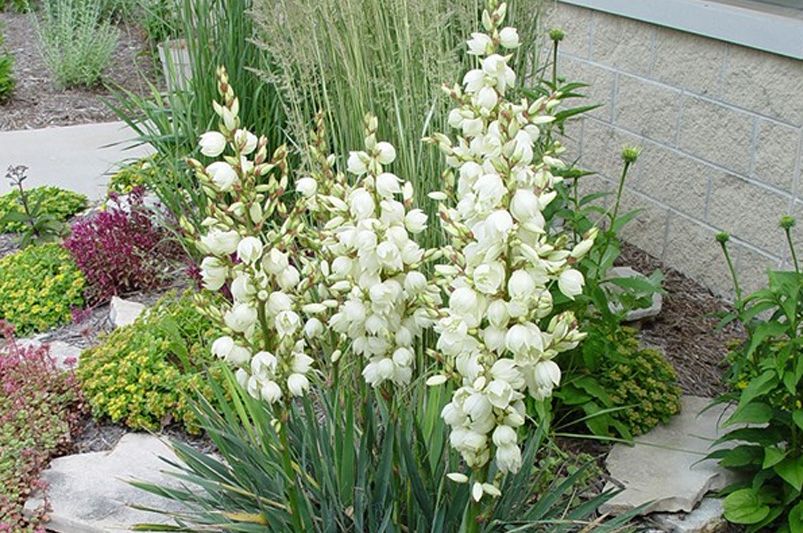
Adam’s Needle
The slow-growing broadleaf evergreen succulent Adam's needle (Yucca filamentosa) is a common addition to Southwest-inspired landscapes. Adam's needle is a yucca plant belonging to the asparagus family. It is an almost stemless shrub with leaves that resemble blades and form a basal rosette. The plant is known by its species name, Filamentosa, for its curly threads that border the edges of its leaves. The foliage clumps are typically 2 to 3 feet tall.
Large flower stalks emerge in late spring or summer from the center of the foliage on mature plants, which are four or five years old. The Adam's Needle Yucca stalks, growing up to 8 feet tall, are crowned with a profusion of creamy white, bell-shaped flowers that draw hummingbirds and butterflies. Although you may plant Adam's needle virtually any time of year, nurseries usually sell them in the spring. The plant's fruits and blooms are edible to humans, but horses, dogs, and cats cannot handle it.
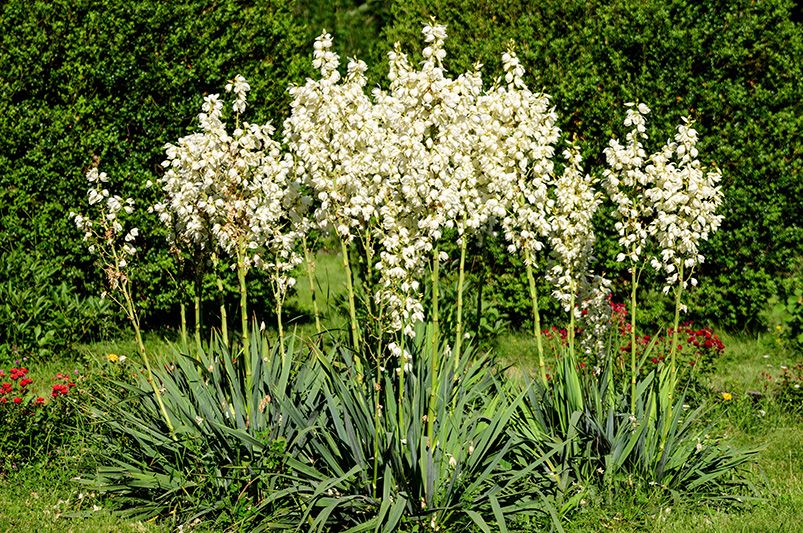
Yucca filamentosa may be the perfect plant for you if landscape maintenance isn't your thing because it requires very little care. Usually, you just need to trim off spent flower stalks at the end of the year and occasionally remove old leaves that have turned brown if you're particular about how your landscape looks.
Even though it grows slowly, leaving 2 to 3 feet of space around this plant is preferable to avoid its sharp, spiky leaves. Plant the specimen at the same level as it grows in the nursery container by excavating a planting hole that is roughly twice as deep and wide. The yucca can decay if you plant it more profoundly than it was in its nursery container, so proceed with caution.
Severe illnesses and insect problems are rare in Yucca filamentosa. Adam's needle serves as the primary pollinator for this plant by drawing yucca moths during the night.
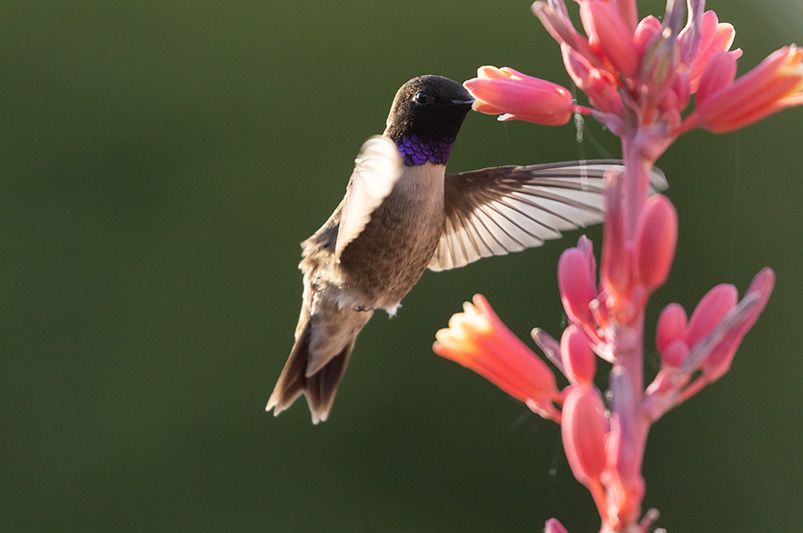
Red Yucca
Although it prefers the sun, red yucca can also grow in moderate shade. However, its flowers will be less frequent. They can also withstand exposure to wind and reflected heat.
Once established, red yucca plants are remarkably resistant to heat and drought. You can sow container-grown plants in the early spring and again in the autumn. This plant thrives in hot, dry, exposed environments.
Hardiness Zones 6–13 and maybe protected areas in Zone 5b are suitable for red yucca survival. They can withstand mild salt in soils and water.
For red yucca, well-draining soil is essential. As long as the area drains properly, plants may adjust to the pH of the soil and are incredibly tolerant of limestone and caliche soils. And even though they thrive in low-fertility areas, they will develop more quickly in environments with plentiful nutrients. Red yucca requires well-drained soil; these plants are virtually maintenance-free if you avoid overwatering them.
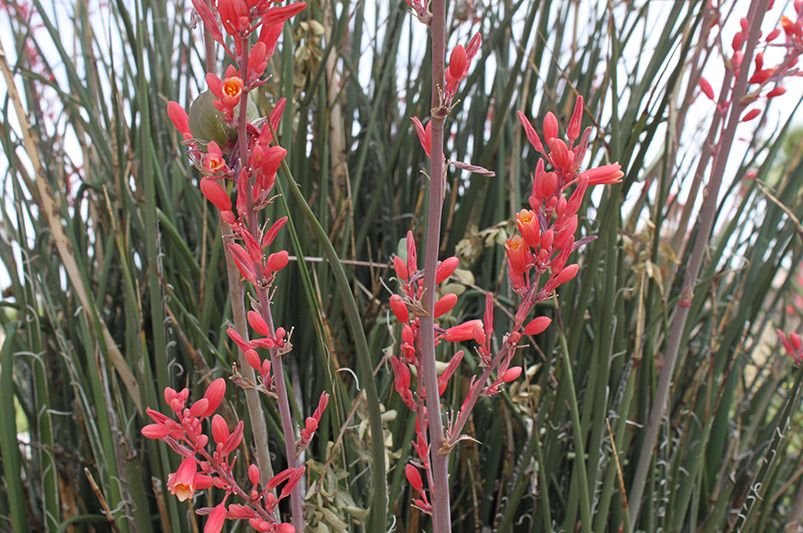
Uses for red yucca: Unlike many xeric succulents, red yucca plants produce eye-catching blooms, and their slow-growing clumps enable the foliage to substitute small shrubs.
Native to Texas, red yucca is a heat- and drought-tolerant plant that grows all over the state. It makes sense to use it in xeric landscapes and rock gardens. Beneath mesquite, paloverde, or other trees provide light-filtered shade, and red yucca makes a great accent plant or small-scale groundcover. Red yucca is appropriate for use in areas where it may come into touch with foot traffic because its leaves don't have sharp points, giving it the variant "soft-leaf yucca."
Other excellent places for red yucca are patio pots, rocky outcroppings, and dry hillsides. Furthermore, due to its prolific flowering, it is a useful addition to pollinator gardens.
Harnessing the Beauty and Practicality of Yucca Plants
Yucca plants offer a resilient and striking addition to any landscape. They thrive in arid conditions with minimal maintenance. From the majestic Adam’s needle with its towering flower stalks to the adaptable red yucca, these plants bring beauty and practicality to gardens across various climates.
If you want to incorporate yucca plants into your landscaping, whether for their drought tolerance or unique appearance, now is the time to take action. Contacting experts like ShrubHub provides tailored advice on selecting the perfect yucca species, optimal placement strategies to avoid root issues, and essential maintenance tips for long-term success. Transform your landscape with yuccas that thrive and enhance your outdoor space.


